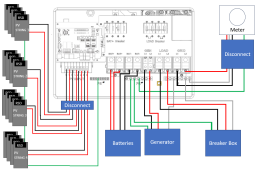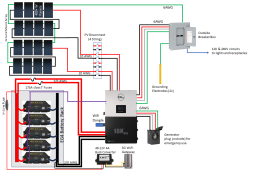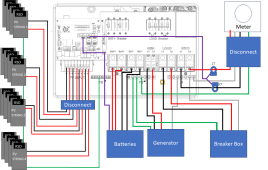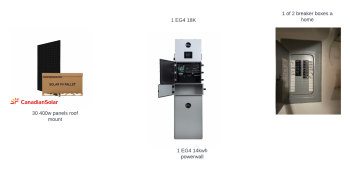Depending on the needs of the system, the EG4 18Kpv can be a reasonably straightforward install
View attachment 161412
The above diagram assumes you are doing a whole-house backup and works for up to a 200A utility feed. The inverter goes between the utility meter and the existing breaker box. The inverter will 'only' produce a continuous 50A @ 240V (12KW) but the run surge capabilities can deal with surges greater than 12KW. For many households, it will carry the load, but if the 'normal' load is higher than 12K the user may need to cut back on some higher-wattage appliances when the power is down.
The AC disconnect may need to be added if there is not one at the meter. The disconnect should be rated for the current rating of your service.
If the service into the home is the full 200A the lines between the meter and the breaker need to be at least 3/0 AWG. However, if the service is 100A the lines can be as 'small' as 2 AWG.
There are a lot of options for the batteries, the EG4 LiFePower batteries can work but I prefer the EG4 LL batteries. There are several other brands that work with the inverter. However, if your state requires the combined Inverter/battery UL listing you may need to stick with the EG4 batteries.
The inverter can pull up to 250A from the batteries and most of the server rack batteries have 100A BMSs so the system needs a minimum of 3 100A server rack batteries. This gives 15.36KWh of storage. Depending on the usage pattern and how long you want to be able to run on batteries alone, you may need more batteries. 6 batteries in a server rack is a common set-up for the 18K pv but some folks have more. From your description, there could be a lot of Air Conditioning so make sure to calculate your need and size the battery bank accordingly.
For the PV disconnect, the
IMO line seems to work pretty well. If you have 4 strings coming in you will need two 2-string switches.
The availability of any particular panel is so short-lived that recommending a specific panel is a fool's errand. You will need to shop around for what works best for you. I like some of the newer 400+ W panels that are out and the 600V pv-in limit of the 18Kpv can handle reasonably long strings with the higher Voc these panels come with.
If your installation is going to have to meet the code you will need to add Rapid Shutdown receiver Modules to the panels. Tigo has a good line of these.
Note: If you have not done it yet, you should spend some time calculating your peak demand wattage and daily KWh usage. This will inform your decision on the size of your battery bank and the size of your solar array. Your current electric bill will often give you most of this data. You can also use one of the whole-house energy monitors that will plot your usage. If you are building from scratch and don't yet have a history to guide you, an energy audit can be very useful:
To get the spreadsheet, click on the orange button at the top of this page. This sheet is intended to help you plan your system. Fill it out down to the last decimal place, look at the results..... and then make your best guess;) Notes...

diysolarforum.com
Finally.... Not shown in the diagram above is a class T fuse between the batteries and the inverter. Some say the battery breakers and BMS over-current is sufficient. However, I like to have a class T fuse between the batteries and the inverter. If you have two server rack batteries, I like to put a fuse after each server rack and then run a cable directly to one of the two battery lugs on the inverter.








